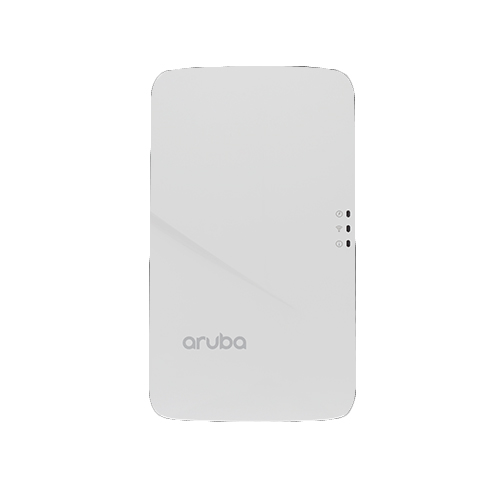$46.32

Aruba 303HR Access Point
| Data Transfer Rate | 867Mbps |
| MIMO | 2x2:2 |
| Power | PoE AC |
| Radio Band | Dual |
| Wireless Type | 802.11 a/b/g/n/ac |
| Environment | Indoor |
Product Highlights
Aruba 303HR, 2.40 GHz 5 GHz, 802.11ac, 867 Mbit/s, 2 x Antenna, MIMO
Aruba 303H Access Point
This access point combines wireless and wired access in a single compact device. It’s ideal for hotels, medical clinics, classrooms, branch offices and remote workstations which often require flexible and easy deployment options.
Three local Gigabit Ethernet ports are available to securely attach wired devices to your network. One of these ports is also capable of supplying PoE power to the attached device.
Integrated Bluetooth Aruba Beacon simplifies the remote management of a large-scale network of battery-powered BLE Aruba Beacons while also providing advanced location and indoor wayfinding, and proximity-based push notification capabilities.
Specifications
Unified dual-radio 802.11ac Wave 2 2x2:2 hospitality and branch AP with internal antennas, three local Gigabit Ethernet ports, PoE out and USB host interface
Supports wall-box and desk mount deployments
AP type: Indoor, dual radio, 5GHz 802.11ac 2x2 MIMO and 2.4GHz 802.11n 2x2 MIMO1
Software-configurable dual radio supports 5GHz (Radio 0) and 2.4GHz (Radio 1)
5GHz: Two spatial stream Multi User (MU) MIMO for up to 867Mbps wireless data rate to up to two (1x1 VHT80) MU-MIMO capable client devices simultaneously
5GHz: Two spatial stream Single User (SU) MIMO for up to 867Mbps wireless data rate to individual 2x2 VHT80 client devices
2.4GHz: Two spatial stream Single User (SU) MIMO for up to 300Mbps wireless data rate to individual 2x2 HT40 client devices
Support for up to 256 associated client devices per radio, and up to 16 BSSIDs per radio
Supported frequency bands (country-specific restrictions apply):
- 2.400 to 2.4835GHz
- 5.150 to 5.250GHz
- 5.250 to 5.350GHz
- 5.470 to 5.725GHz
- 5.725 to 5.850GHz
Available channels: Dependent on configured regulatory domain
Dynamic frequency selection (DFS) optimizes the use of available RF spectrum
Supported radio technologies:
- 802.11b: Direct-sequence spread-spectrum (DSSS)
- 802.11a/g/n/ac: Orthogonal frequency-division multiplexing (OFDM)
Supported modulation types:
- 802.11b: BPSK, QPSK, CCK
- 802.11a/g/n/ac: BPSK, QPSK, 16-QAM, 64-QAM, 256-QAM
Transmit power: Configurable in increments of 0.5 dBm
Maximum (conducted) transmit power (limited by local regulatory requirements):
- 2.4GHz band: +18 dBm per chain, +21 dBm aggregate (2x2)
- 5GHz band: +18 dBm per chain, +21 dBm aggregate (2x2)
- Note: conducted transmit power levels exclude antenna gain. For total (EIRP) transmit power, add antenna gain
Advanced Cellular Coexistence (ACC) minimizes interference from cellular networks
Maximum ratio combining (MRC) for improved receiver performance
Cyclic delay/shift diversity (CDD/CSD) for improved downlink RF performance
Short guard interval for 20MHz, 40MHz and 80MHz channels
Space-time block coding (STBC) for increased range and improved reception
Low-density parity check (LDPC) for high-efficiency error correction and increased throughput
Transmit beam-forming (TxBF) for increased signal reliability and range
Supported data rates (Mbps):
- 802.11b: 1, 2, 5.5, 11
- 802.11a/g: 6, 9, 12, 18, 24, 36, 48, 54
- 802.11n (2.4GHz): 6.5 to 300 (MCS0 to MCS15)
- 802.11n (5GHz): 6.5 to 450 (MCS0 to MCS23)
- 802.11ac: 6.5 to 867 (MCS0 to MCS9, NSS = 1 to 2 for VHT20/40/80)
802.11n high-throughput (HT) support: HT 20/40
802.11ac very high throughput (VHT) support: VHT 20/40/80
802.11n/ac packet aggregation: A-MPDU, A-MSDU
-
Quantity Discounts10+Contact
-
Aruba Wall Mount
( SKU: 7V3556 )
Aruba Wall Mount, 303H Series, Optional Dual-gang Wall-box Mount Adapter
$46.32
Quantity Discounts10+Contact -
$46.32
Quantity Discounts10+Contact


